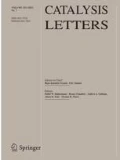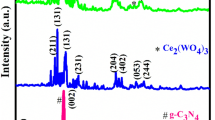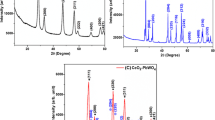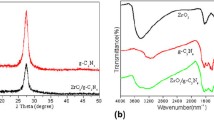Abstract
The development of highly active and resource-rich cocatalysts is important for the replacement of precious metals by the realization of large-scale and low-cost photocatalytic decomposition of water to hydrogen production. Here, we report that Ce/CoWO4 has been prepared by the microwave method and has good photocatalytic H2 properties. Under visible light irradiation (≥ 420 nm), the optimized hydrogen yield of the Ce/CoWO4 (10%) photocatalyst was 200.89 µmol, which was three times that of CoWO4. Based on the results of photoelectrochemistry and PL measurements, it is proposed that CeO2 can not only quickly capture photo-generated electrons from excited CoWO4 to improve the efficiency of charge separation, but also promote the reduction of H+–H2. View of its high activity, low cost and ease of preparation, the catalyst is a compound having a high application potential of the photocatalyst.
Graphical Abstract
The Ce/CoWO4 was successfully synthesized by the microwave method, and the composite catalyst showed excellent photocatalytic activity in the dye-sensitized system, which was about three times higher than that of CoWO4. The CeO2 on the surface of CoWO4 provided the more active sites and improved the efficiency of photo-generated charge separation. The Ce/CoWO4 composite catalyst is a highly efficient photocatalyst with potential applications.










Similar content being viewed by others
References
Bai X, Wang L, Zhu Y (2016) Visible photocatalytic activity enhancement of ZnWO4 by graphene hybridization. ACS Catal 2(12):2769–2778
Cui Y, Li H, Hong W et al (2013) The effect of carbon content on the structure and photocatalytic activity of nano-Bi2WO6, powder. Powder Technol 247:151–160
Moniz SJA, Shevlin SA, Martin DJ et al (2015) Visible-light driven heterojunction photocatalysts for water splitting—a critical review. Energy Environ Sci 8(3):731–759
Li X, Yu J, Low J et al (2015) Engineering heterogeneous semiconductors for solar water splitting. J Mater Chem A 3(6):2485–2534
Ma Y, Wang X, Jia Y et al (2014) Titanium dioxide-based nanomaterials for photocatalytic fuel generations. Chem Rev 114(19):9987
López XA, Fuentes AF, Zaragoza MM (2016). Synthesis, characterization and photocatalytic evaluation of MWO4, (M = Ni, Co, Cu and Mn) tungstates. Int J Hydrog Energy 41(48):23312–23317
Trzciński K, Szkoda M, Sawczak M et al (2016) Visible light activity of pulsed layer deposited BiVO4/MnO2, films decorated with gold nanoparticles: the evidence for hydroxyl radicals formation. Appl Surf Sci 385:199–208
Ying X, Mo Y, Jing T et al (2016) The synergistic effect of graphitic N and pyrrolic N for the enhanced photocatalytic performance of nitrogen-doped graphene/TiO2, nanocomposites. Appl Catal B Environ 181:810–817
Cheng F, Yin H, Xiang Q (2016) Low-temperature solid-state preparation of ternary CdS/g-C3N4/CuS nanocomposites for enhanced visible-light photocatalytic H2 -production activity. Appl Surf Sci 391:432–439
Yu H, Xu J, Guo H et al (2017) Synergistic effect of rare earth metal Sm oxides and Co1–xS on sheet structure MoS2 for photocatalytic hydrogen evolution. RSC Adv 7(89):56417–56425
Peng Y, Yan M, Chen QG et al (2014) Novel one-dimensional Bi2O3–Bi2WO6 p–n hierarchical heterojunction with enhanced photocatalytic activity. J Mater Chem A 2(22):8517–8524
Xu X, Shen J, Li N et al (2014) Facile synthesis of reduced graphene oxide/CoWO4, nanocomposites with enhanced electrochemical performances for supercapacitors. Electrochim Acta 150:23–34
Bhattacharya C, Lee HC, Bard AJ (2015) Rapid screening by scanning electrochemical microscopy (SECM) of dopants for Bi2WO6 improved photocatalytic water oxidation with Zn doping. J Phys Chem C 117(19):9633–9640
Yu C, Cao F, Li X et al (2013) Hydrothermal synthesis and characterization of novel PbWO4, microspheres with hierarchical nanostructures and enhanced photocatalytic performance in dye degradation. Chem Eng J 219(3):86–95
Lv H, Liu Y, Jing G et al. (2016) Shape-selective synthesis of Bi2WO6 hierarchical structures and their morphology-dependent photocatalytic activities. RSC Adv 6(83):80226–80233
Zhang N, Chen D, Cai B et al (2016) Facile synthesis of CdS, ZnWO4, composite photocatalysts for efficient visible light driven hydrogen evolution. Int J Hydrog Energy 42(4):1962–1969
Sivakumar M, Madhu R, Chen SM et al. (2016) Low temperature chemical synthesis of CoWO4 nanospheres for sensitive non-enzymatic glucose sensor. J Phys Chem C, 120:17024–17028
Xu X, Gao J, Huang G (2015) etal. Fabrication of CoWO4@NiWO4, nanocomposites with good supercapacitve performances. Electrochim Acta 174:837–845
Ling C, Zhou L, Jia H (2014) First-principles study of crystalline CoWO4 as oxygen evolution reaction catalyst. RSC Adv 4(47):24692–24697
Yan X, Wu Z, Huang C et al (2017) Hydrothermal synthesis of CdS/CoWO4, heterojunctions with enhanced visible light properties toward organic pollutants degradation. Ceram Int 43(7):5388–5395
Grewe T, Deng X, Weidenthaler C et al (2013) Design of ordered mesoporous composite materials and their electrocatalytic activities forwater oxidation. Chem Mater 25(24):4926–4935
Li A, Li A, Li A (2017) CoWO4 Nanoparticles prepared in different solvents and their pseudocapacitant performances. Int J Electrochem Sci 12(6):5646–5656
Ahmed MI, Adam A, Khan A et al (2016) Improved photoelectrochemical water oxidation under visible light with mesoporous CoWO4. Mater Lett 183:281–284
Li W, Ma S, Yang G et al (2015) Preparation, characterization and gas sensing properties of pure and Ce doped ZnO hollow nanofibers. Mater Lett 138:188–191
Lamba R, Umar A, Mehta SK et al (2015) CeO2-ZnO hexagonal nanodisks: efficient material for the degradation of direct blue 15 dye and its simulated dye bath effluent under solar light. J Alloys Compd 620(620):67–73
Kumar R, Umar A, Kumar G et al (2015) Ce-doped ZnO nanoparticles for efficient photocatalytic degradation of direct red-23 dye. Ceram Int 41(6):7773–7782
Ahmad M, Ahmed E, Zafar F et al (2015) Enhanced photocatalytic activity of Ce-doped ZnO nanopowders synthesized by combustion method. J Rare Earths 33(3):255–262
Wen XJ, Niu CG, Zhang L et al (2018) Photocatalytic degradation of ciprofloxacin by a novel Z-scheme CeO2–Ag/AgBr photocatalyst: influencing factors, possible degradation pathways, and mechanism insight. J Catal 358:141–154
Primo A, Marino T, Corma A et al (2011) Efficient visible-light photocatalytic water splitting by minute amounts of gold supported on nanoparticulate CeO2 obtained by a biopolymer templating method. J Am Chem Soc 133(18):6930
Liu D, Jin Z, Li H et al. (2017) Modulation of the excited-electron recombination process by introduce g-C3N4, on Bi-based bimetallic oxides photocatalyst. Appl Surf Sci 423:255–265
Acknowledgements
This work was supported by Natural Science Foundation of Ningxia Province (NZ17262) and Foundation of Key Laboratory of Electrochemical Energy Conversion Technology and Application at North Minzu University (2018KLEA02).
Author information
Authors and Affiliations
Corresponding author
Rights and permissions
About this article
Cite this article
Liu, Z., Xu, J., Li, Y. et al. High Performance Photocatalytic Based on Ce Doped CoWO4: Controllable Synthesis and Enhanced Photocatalytic Activity. Catal Lett 148, 3205–3213 (2018). https://doi.org/10.1007/s10562-018-2518-x
Received:
Accepted:
Published:
Issue Date:
DOI: https://doi.org/10.1007/s10562-018-2518-x




